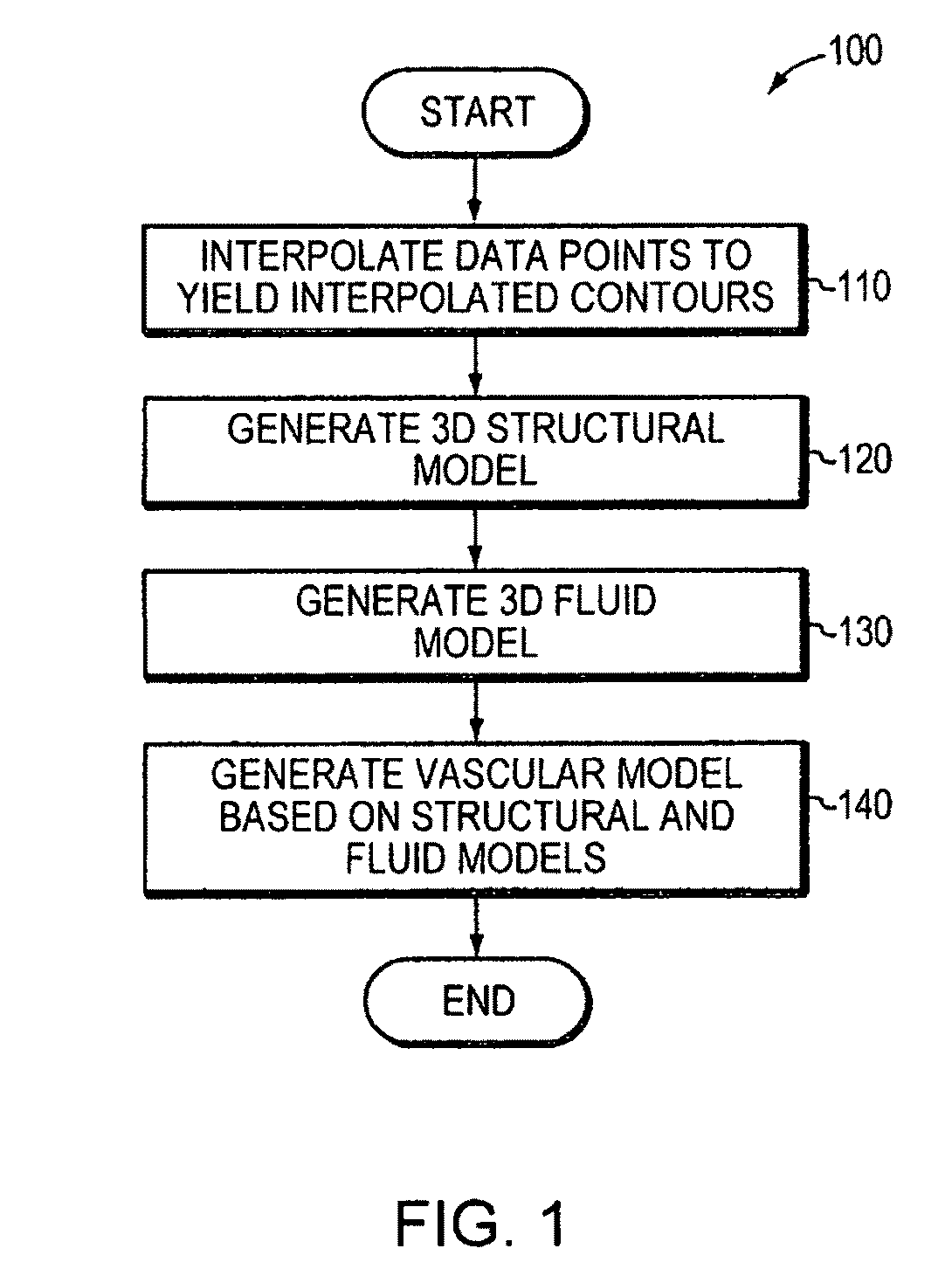Automatic vascular model generation based on fluid-structure interactions (FSI)
a technology of fluid structure interaction and vascular model, applied in the field of automatic vascular model generation based on fluid structure interaction, can solve the problems of insufficient detection and diagnosis methods, insufficient understanding of plaque rupture responsible for stroke or cardiac arrest, and current technology for diagnosing applicable cardiovascular diseases, etc., to achieve automatic and accurate modeling of mechanical distribution(s)
- Summary
- Abstract
- Description
- Claims
- Application Information
AI Technical Summary
Benefits of technology
Problems solved by technology
Method used
Image
Examples
embodiment 100
[0040]FIG. 1 is a flow diagram of an embodiment 100 of the invention, which is a process that transforms raw data into a 3D vascular model, i.e., a model representing 3D characteristics of a blood vessel including fluid-structure interactions (FSIs). The raw data may include contour data describing the geometric configuration of plaques within the blood vessel, as well as material properties and other indicators such as blood pressure. Data points corresponding to a contour of a blood vessel are interpolated (110) to yield an interpolated contour. Such interpolation occurs for various contours in a 2D slice of data, which may be obtained via an earlier data collection step. A structural model, representing three-dimensional structural characteristics of the blood vessel, is generated (120) based on multiple interpolated contours corresponding to different 2D slices. A fluid model that represents 3D characteristics of fluid flow within the vessel is also generated (130). Finally, a v...
embodiment 200
[0042]FIG. 2 is a flow diagram showing an end-to-end analytical framework in accordance with an embodiment 200 of the invention. In this framework, M2VPA is one component of the framework, along with input data and a finite element simulation software, such as the commercial finite-element package ADINA® (Adina R&D, Inc., Watertown, Mass., USA). Data corresponding to plaque geometries, i.e., contour data, as well as material properties and blood pressure, are input for processing (210). Known user interface techniques for prompting user entry of these data are utilized. M2VPA performs operator-assisted automatic mesh generation (220) using a technical computing environment, such as MATLAB® (The Mathworks, Inc. Natick, Mass., USA) and exports ready-to-run simulation data, such as ADINA®-readable data, for 2D solid, 3D solid-only, 3D fluid-only, and vascular (FSI) models (230). The finite element simulation software performs computational simulations, e.g., to compute 2D / 3D stress and...
embodiment 400
[0047]FIG. 4 is a block diagram of the main modules of an embodiment 400 of the invention. The four main modules are: (1) a first module 410 for data transformation and processing; (2) a second module 420 for 3D structure reconstruction; (3) a third module 430 for fluid domain reconstruction; and (4) a fourth module 440 for critical mechanical condition analysis.
[0048]The first module 410 performs data input and pre-processing, including interpolation of data points along contours. The second module 420 creates component-fitting lines and surfaces for each 2D slice, connects slices, makes surfaces linking slices, and forms component-fitting volumes; generates a mesh for every volume created; and assigns material properties to each volume. The third module 430 is similar to the second module 420, but applies to the fluid domain. The second module 420 and the third module 430 generate data used to solve a 3D fluid-structure interaction (FSI) model. Typically, modules 420 and 430 gener...
PUM
 Login to View More
Login to View More Abstract
Description
Claims
Application Information
 Login to View More
Login to View More - R&D
- Intellectual Property
- Life Sciences
- Materials
- Tech Scout
- Unparalleled Data Quality
- Higher Quality Content
- 60% Fewer Hallucinations
Browse by: Latest US Patents, China's latest patents, Technical Efficacy Thesaurus, Application Domain, Technology Topic, Popular Technical Reports.
© 2025 PatSnap. All rights reserved.Legal|Privacy policy|Modern Slavery Act Transparency Statement|Sitemap|About US| Contact US: help@patsnap.com



